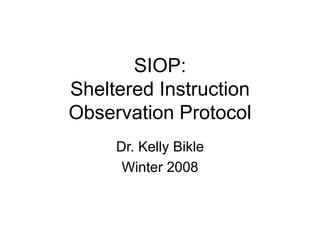
SIOP.ppt
- 1. SIOP: Sheltered Instruction Observation Protocol Dr. Kelly Bikle Winter 2008
- 2. Our objectives • To learn about the SIOP as an effective planning tool for educating ELLs • To think about the elements of the SIOP in relation to our particular planning needs • To gather an array of teaching strategies that are effective for working with ELLs • To provide enough information to get you started as a teacher for ELLs, AND to encourage you to continue growing as a professional educator
- 3. What is the SIOP? • A planning tool and observation protocol representing an effort to define, develop and test a model for sheltered instruction (SDAIE) – Research-based – Designed as an observation instrument – Adapted as a lesson planning tool – Teacher-researchers involved in all phases!!!!
- 4. SIOP: An Integrated Approach • Instructional methods integrate language and content • Focus on identifying, explicitly teaching, and providing opportunities to use the language necessary to access, to fully participate in and to be successful with the curriculum • Language instruction occurs within content instruction--not as an “add-on”
- 5. Sheltered Instruction Observation Protocol Components • Preparation • Building Background • Comprehensible Input • Strategies • Interaction • Practice/Application • Effective lesson delivery • Lesson review/Assessment
- 6. Preparation • Clearly defined content objectives • Clearly defined language objectives ***** • Content concepts appropriate for age and educational level of students • Supplementary materials used to a high degree • Adaptation of content to all levels of student proficiency • Meaningful activities that integrate lesson concepts with opportunities to use language
- 7. Activity: Think, Write, Share --Review reading from today (use your book). --Take notes on important points. --Talk with your tablemates. Take notes on what each person says.
- 8. Activity: Language Demands • What are the language demands in this lesson in each of the four domains? Reading * * Writing * * Speaking * * Listening * *
- 9. Thinking about objectives • Learning objectives (goals, outcomes) • Language objectives CAELD/TESOL Standards Content Language Demands Student Needs/ Language Proficiency Possible language objectives
- 10. Language Objectives • Ask yourself, “Based on the language demands of the particular lesson, my students needs, and the larger goals (unit plan, district goals, standards, etc.), what do I want students to be able to do at the end of the lesson?” • Write objectives that have measurable outcomes, and are specific to the language you would like to see your students demonstrating in one or more of the four domains.
- 11. Activity: From Lg. Demands to Lg. Objectives • If you were going to ask a university-level ELL to do this activity, what might you focus on and how might you support work toward that objective? • With a partner, select a language demand, write an objective and brainstorm ideas for how you might support the objective.
- 12. Comprehensible Input and Language Demands • Speech appropriate for proficiency level • Clear explanation of academic tasks • A variety of techniques use to make content concepts clear
- 13. Language Demands • An analysis for language demands tells you what students will need to do with language in order to be success with the lesson/task. What else can you use language demands for? • Design mini-lessons around specific language skills (anything from pronunciation to skills to enter a conversation) • Know the challenges that students face and be ready to support students in the areas that are of particular struggle (and note commonalities to use for future planning) • Adjust instruction to support students in the areas you anticipate will be challenging • Adjust assessments accordingly--take the language demands into account when you look at student products.
- 14. Today’s strategies • Sharing objectives • Think-Write-Share • Graphic organizer for note-taking • Visual representation of information • Moving from own experience to more abstract • Structured reading response • 3-2-1 Activity
- 15. 3-2-1 3 things you found interesting (use phrases): 1. _______ 2. _______ 3. _______ 2 things that are new to you: 1. _______ 2. _______ 1 thing you would like to know more about: 1. _______